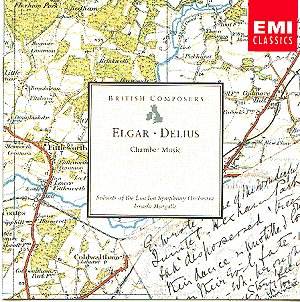Edward ELGAR (1857 -
1934)
Piano Quintet in A Minor Op. 84 35'34"
Sospiri Op.70* 3'28"
The Farm Yard (Harmony Music No 4)** 13'49"
Frederick DELIUS (1862 -
1934)
Violin Sonata No 3 16'47"
Violin Sonata No 2* 11'27"
Violin Sonata No 1* 20'30"
Cello Sonata*
14'20"
 Soloists of the London Symphony
Orchestra & Isreala Margalit.
Soloists of the London Symphony
Orchestra & Isreala Margalit.
Recording details. CD1 Unitarian Chapel, Rosslyn Hill, London 10 Dec
1994 And All Saints, East Finchley 29 Sept* and 29 Nov 1995** CD2 Conway
Hall, London 3 Oct 1994* and 4 Oct 1994 DDD
EMI British Composers CZS 5 73992 2 CDI 52'51" CD2
63'04"
Crotchet
Amazon
UK Amazon USA

Chamber Music by Elgar and Delius, two of the triumvirate of English composers
who died in the same year of 1934 (Gustav Holst was the third), is combined
to make up this double CD in the British Composers Series from EMI. Musically
there is not a lot of common ground between the two men. Neither is best
remembered for his chamber music and this recording may introduce it to new
listeners.
The Piano Quintet dates from 1918 / 19 when Elgar was having a settled, happy
and artistically fruitful life. It was the late flowering period during which
he wrote his Violin Sonata, String Quartet and the Cello Concerto - his last
major works, as following his wife's death in 1920 he virtually gave up
composition.
The performers are not a named group but, apart from the pianist, are all
orchestral players from the LSO. They give a committed reading with a thoughtful
approach to this contemplative, dignified work of Elgar's later years. The
opening Moderato with its delightful mood changes is very
appealing ,while the long breathed melody in the Allegro is ravishing.
The bold and brisk approach taken to the Finale closes a satisfying
reading. The balance at times allowed the louder piano chords to dominate
otherwise the ensemble is excellent.
Elgar wrote Sospiri in 1914 and as played on this disc by violin and
piano it makes a contrast with its better known self for Strings, Harp and
Organ. Just a tiny work - once heard it haunts the listener. The word means
sighs and the hearer can read into the music whatever he wishes about
the composer's thoughts as he wrote it. There surely is an untold story there
somewhere.
The quaintly titled The Farm Yard has a curious history. As a young
man of twenty Elgar was appointed leader to a local Orchestra in Worcester.
Because he was expected to coach players on their own instruments he took
up the bassoon, quickly formed a Wind Quintet and proceeded to write music
for it. This piece for two flutes, oboe, clarinet and bassoon is the composer's
first attempt at a large-scale sonata-form structure. It turns out to be
an attractive work with lots of contrapuntal interplay and a number of snippets
of promising themes and could well become a staple piece for a wind quintet
- perhaps as an Innocent Ear test on the audience.
A CD of three Violin Sonatas and a Cello Sonata by Delius may not sound overly
gripping to the potential buyer, but if he does take the plunge I think he
may surprise himself and might even enjoy his purchase. There are in fact
four violin sonatas, the earliest dating from 1892 was rejected by the composer
until it was published in 1977. The three on the disc are - like Miss World
- in reverse order.
Violin Sonata No 3 to give it its full title, dates from 1930, the period
when dictating to Eric Fenby was enabling the very sick Delius to continue
to compose. Fenby found some sketches existed for the work that pre-dated
it before No 2 and these were incorporated. Alexander Barantschik and Israela
Margalit seem in perfect accord over interpretation - especially in the rather
strange middle movement that begins as a slightly jaunty passage then switches
to a broad slow theme.
For the other two Sonatas the pianist changes her partner to Janice Graham.
No 2 (from 1923) needed Delius' wife to enable him to write the score from
his dictation - he could still see at this time. The work has three linked
movements , with, notably a lento movement with an entrancing string melody.
No 1- begun in 1905 and completed 10 years later - is written without a break
and is the longest of the three. As previously the duo make a deeply committed
pairing.
The Cello Sonata dates from 1916 and is in a continuous but clearly defined
three-section form. Soloist Moray Welsh has a full, rich tone and with expressive
phrasing the busy cello part is a feature of the piece that seems to dwell
on a Delius warmer and more approachable than in the later works on the disc.
Not everyone's cup of tea, but there are goodies in the disc if you persevere.
Reviewer
Harry Downey

